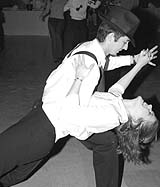 |
It
don’t mean a thing if it ain’t got that swing The lights from the disco ball follow the movement of the couples dancing on the floor below. The big band fills the stage as their brass sound blasts out onto the dance floor. Dancers crowd the floor, some clad in the traditional garb of the ‘30s; flowing skirts, saddle shoes and zoot suits. One dancer in particular stands out. He moves smoothly in his fedora hat, pinstripe suit and slick saddle shoes. Energetically dancing to the fast paced music, Chris O’Connor, a freshman pre-major, who has been swinging for three and a half years often can be found at the Southside Preservation Hall on Tuesday nights. The Hall, which provides mostly wedding functions and cooking classes, travels back to the ‘30s every Tuesday night and on the first Friday of the month and becomes the Swing Castle. The popularity of jazz and swing dancing peaked in the post-war era. It has stayed alive through those who truly love this unique style of dance. Now, swing has morphed to fit the modern scene, but retains its traditional qualities. “Swing now has a more showy aspect to it with all of the jumps and flips,” O’Connor said. “In the ‘30s, the dance floor was really crowded so the Shag and Balboa were some of the most popular dances, not the Lindy Hop. You can do the Lindy Hop now because there is more room. The Boogie-woogie style is not really as popular now either, and certain styles that were popular then are not popular at all now.” O’Connor said he prefers the Lindy Hop because of the dance’s versatility and complexity. He usually Lindy Hops with whomever, but a few of his regular partners include Niki Clausen, a junior speech communications major, and Holly McClung, a freshman theatre major. McClung said
she learned how to swing dance the beginning of her freshman year.
McClung said she likes swing dancing because it is a partner dance, which people do not participate in often since group dancing is popular. “I like it because it is something you have to learn,” McClung said. “You can’t just go out there and move to the music, it’s a skill.” Swing dancing was originally the result of the ever growing popularization of jazz and swing music, and a rebellion against authority and restrictive dancing. “I don’t think it’s seen in the same light,” O’Connor said. “It is much more tame in perspective to other dancing that is more risqué. My grandmother thinks it’s great that I swing. Now it isn’t to rebel but is kind of the opposite.” McClung agrees. “People swing not to rebel against their parents, but to rebel against the people who are rebelling,” McClung said. “When teens rebel now, they move towards alcohol, and swing isn’t really like that.” She said that since it is real dancing that it cannot be done while drinking, because the steps require concentration, and cannot be done while smoking, because the energetic dance requires good breathing. “It’s fun to go and dance with someone and not have to go to a club and come back all smoky,” O’Connor said. “It has a great atmosphere.” Danielle Gueguen, a freshman international relations major who just recently started swing dancing to do “something different,” has a similar view. “One of my friends asked me if I wanted to go, so I went,” Gueguen said. “At first I thought it was a hole in the wall, but when we walked in and I was very impressed with how much work they put into it and how devoted they were. It was an amazing atmosphere with the big band and the people dressed in ‘30s style and felt like everyone was part of a big family.” McClung felt the same way about the family-like atmosphere of the Hall. “It is very open,” she said. “If you are a beginner no one really looks down on you. It doesn’t matter if you can’t dance or if you are showing off. You can wear whatever and the people accept you. It is a good place just to dance and get to know people. It is kind of like a community.” O’Connor, who started swing dancing in Phoenix and never really took any lessons, said he loves to learn new moves. “At Swing Castle, I Iook at the people who are really good and want to do what they do and be as good as they are,” O’Connor said. “But, people come up to me and tell me how good they think I am. There’s a hierarchy, but everyone still has a great time. It really is a community where everyone knows each other.” This “community” was made possible by the Southside Preservation Association. Steve Lipsett, a real estate agent who is on the board of directors and the Swing Castle’s D.J., helped find the building. The 60,000 square foot building was originally the Old Methodist Church. The previous owners, the Boys and Girls Club who built the northern addition, were going to turn the building into a soccer field, Lipsett said. “A group of us started doing swing when it was still in downtown Fort Worth,” Lipsett said. “The different places started to close down, so we brought it here.” March 26, 1999 was the first night of the Swing Castle, which was the name given to the swing events. “The first night we had four people,” Lipsett said. “It took a couple of months to get started. We went to the Caravan of Dreams and passed out cards to get people to come. Most of the people who come know about it from word of mouth, our best advertising.” Since the Southside Preservation Association is a non-profit organization, all of the proceeds made by Swing Castle go towards fixing up the building. The dance instructors do not even get paid. “Tommy and Mira Hoyler, Brad Gruber and Jennifer Ashbrook love sharing the joy of dancing,” Lipsett said. “We all feel swing is an art form and we don’t want to let it die.” Sarah
Krebs |
|||
|
TCU Daily Skiff © 2002 |
||||


